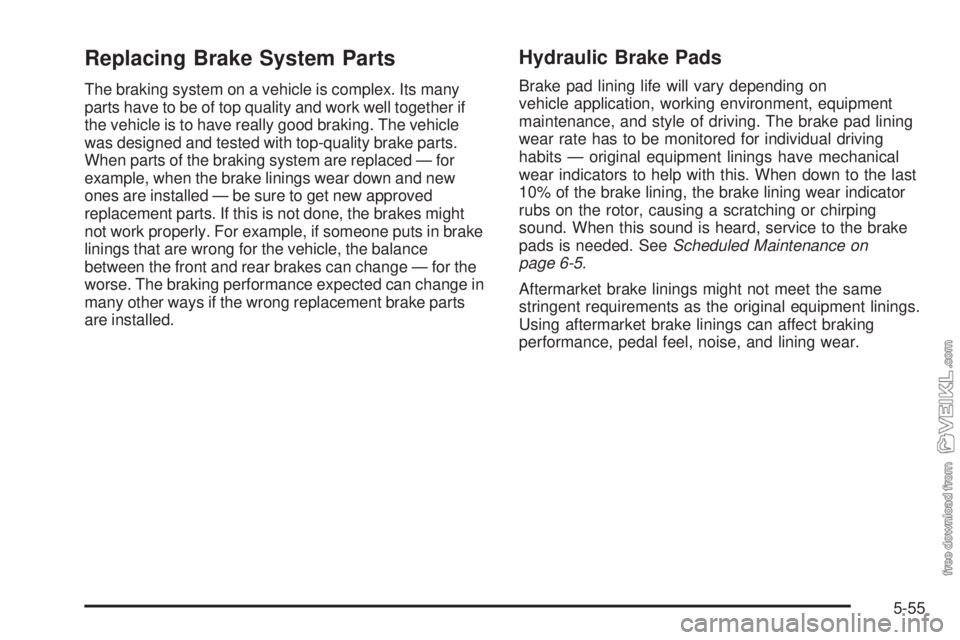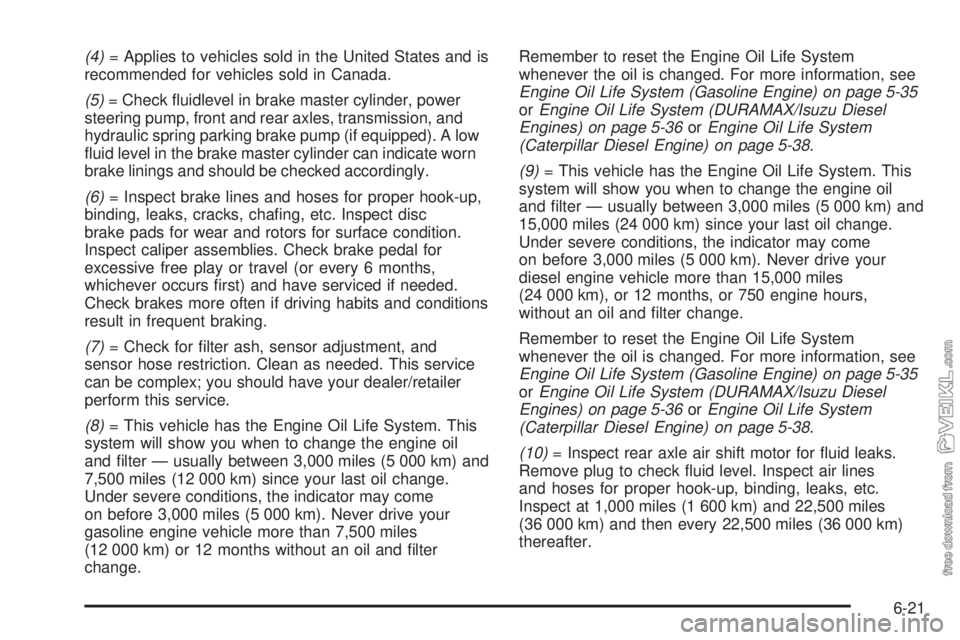brake rotor CHEVROLET KODIAK 2009 Owners Manual
[x] Cancel search | Manufacturer: CHEVROLET, Model Year: 2009, Model line: KODIAK, Model: CHEVROLET KODIAK 2009Pages: 376, PDF Size: 5.39 MB
Page 257 of 376

Replacing Brake System Parts
The braking system on a vehicle is complex. Its many
parts have to be of top quality and work well together if
the vehicle is to have really good braking. The vehicle
was designed and tested with top-quality brake parts.
When parts of the braking system are replaced — for
example, when the brake linings wear down and new
ones are installed — be sure to get new approved
replacement parts. If this is not done, the brakes might
not work properly. For example, if someone puts in brake
linings that are wrong for the vehicle, the balance
between the front and rear brakes can change — for the
worse. The braking performance expected can change in
many other ways if the wrong replacement brake parts
are installed.
Hydraulic Brake Pads
Brake pad lining life will vary depending on
vehicle application, working environment, equipment
maintenance, and style of driving. The brake pad lining
wear rate has to be monitored for individual driving
habits — original equipment linings have mechanical
wear indicators to help with this. When down to the last
10% of the brake lining, the brake lining wear indicator
rubs on the rotor, causing a scratching or chirping
sound. When this sound is heard, service to the brake
pads is needed. SeeScheduled Maintenance on
page 6-5.
Aftermarket brake linings might not meet the same
stringent requirements as the original equipment linings.
Using aftermarket brake linings can affect braking
performance, pedal feel, noise, and lining wear.
5-55
Page 335 of 376

(4)= Applies to vehicles sold in the United States and is
recommended for vehicles sold in Canada.
(5)= Check fluidlevel in brake master cylinder, power
steering pump, front and rear axles, transmission, and
hydraulic spring parking brake pump (if equipped). A low
fluid level in the brake master cylinder can indicate worn
brake linings and should be checked accordingly.
(6)= Inspect brake lines and hoses for proper hook-up,
binding, leaks, cracks, chafing, etc. Inspect disc
brake pads for wear and rotors for surface condition.
Inspect caliper assemblies. Check brake pedal for
excessive free play or travel (or every 6 months,
whichever occurs first) and have serviced if needed.
Check brakes more often if driving habits and conditions
result in frequent braking.
(7)= Check for filter ash, sensor adjustment, and
sensor hose restriction. Clean as needed. This service
can be complex; you should have your dealer/retailer
perform this service.
(8)= This vehicle has the Engine Oil Life System. This
system will show you when to change the engine oil
and filter — usually between 3,000 miles (5 000 km) and
7,500 miles (12 000 km) since your last oil change.
Under severe conditions, the indicator may come
on before 3,000 miles (5 000 km). Never drive your
gasoline engine vehicle more than 7,500 miles
(12 000 km) or 12 months without an oil and filter
change.Remember to reset the Engine Oil Life System
whenever the oil is changed. For more information, see
Engine Oil Life System (Gasoline Engine) on page 5-35
orEngine Oil Life System (DURAMAX/Isuzu Diesel
Engines) on page 5-36orEngine Oil Life System
(Caterpillar Diesel Engine) on page 5-38.
(9)= This vehicle has the Engine Oil Life System. This
system will show you when to change the engine oil
and filter — usually between 3,000 miles (5 000 km) and
15,000 miles (24 000 km) since your last oil change.
Under severe conditions, the indicator may come
on before 3,000 miles (5 000 km). Never drive your
diesel engine vehicle more than 15,000 miles
(24 000 km), or 12 months, or 750 engine hours,
without an oil and filter change.
Remember to reset the Engine Oil Life System
whenever the oil is changed. For more information, see
Engine Oil Life System (Gasoline Engine) on page 5-35
orEngine Oil Life System (DURAMAX/Isuzu Diesel
Engines) on page 5-36orEngine Oil Life System
(Caterpillar Diesel Engine) on page 5-38.
(10)= Inspect rear axle air shift motor for fluid leaks.
Remove plug to check fluid level. Inspect air lines
and hoses for proper hook-up, binding, leaks, etc.
Inspect at 1,000 miles (1 600 km) and 22,500 miles
(36 000 km) and then every 22,500 miles (36 000 km)
thereafter.
6-21